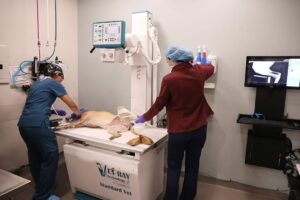Sacroiliac Dislocation: Signs, Diagnosis and Treatment
A sacroiliac dislocation is a traumatic injury to the pelvis in which the joint that normally holds the pelvis onto the spine is torn loose and shifts out of place. Because the pelvis is like a box, it must be broken in at least one or two other places in the pelvis for the bones to be unstable.
Anatomy
Anatomically, the pelvis is somewhat like a rectangular box. Thus the entire normal pelvis should fit within the rectangle. If a portion of the pelvis is lying outside of the box, either a fracture or dislocation of the pelvis is present.
The front part of the pelvis is normally attached to the spine by the sacroiliac joint. The hips are connected to the mid part of the pelvis. The colon, urethra, and vagina pass through the pelvic canal. The sciatic nerve extends from the lower spine and runs just below the sacroiliac joint and then passes through the canal of the pelvis to the hind limbs. The sciatic nerve is critical for hind limb muscle function.
Signs and Diagnosis
The most common cause of a sacroiliac dislocation is trauma such as being struck by a motorized vehicle or taking a fall. Affected pets will bear minimal to no weight on the dislocated side of the pelvis. If both sides of the pelvis are dislocated, then the pet may not be able to walk at all.
 X-rays are required to make a diagnosis of a sacroiliac joint. Damage to the sciatic nerve may occur from direct trauma to the pet during the accident or may occur if the nerve gets trapped between fractured bones; therefore, the nerve function will be carefully evaluated prior to surgery.
X-rays are required to make a diagnosis of a sacroiliac joint. Damage to the sciatic nerve may occur from direct trauma to the pet during the accident or may occur if the nerve gets trapped between fractured bones; therefore, the nerve function will be carefully evaluated prior to surgery.
The surgeon will also evaluate the urinary tract to make sure that the bladder has not been ruptured. In addition, chest X-rays are made to ensure that there is no trauma to lungs, ribs or diaphragm. Should there be significant trauma to these other organs, surgery may be delayed so that your companion can safely undergo surgery.
Surgery
Sacroiliac fracture repair will allow your pet to recover faster than a conservative approach (no surgery). However, a minimally displaced sacroiliac luxation can be managed conservatively and typically will heal with a good outcome.
Sacroiliac luxations should be surgically stabilized if there is moderate to severe displacement of the pelvic bone from the spine; if both left  and right sacroiliac joints are dislocated; or if your companion has signs of sciatic nerve injury.
and right sacroiliac joints are dislocated; or if your companion has signs of sciatic nerve injury.
If the sciatic nerve function is impaired, surgery should be performed as soon as possible to release pressure off the nerve, which will help to prevent permanent damage. Dislocation of the sacroiliac joint is repaired using one or two screws and potentially a pin.
If possible, surgery is performed with the aid of interventional radiography and one or two very small incisions; otherwise, a traditional open surgical approach (larger incision) and repair of the dislocation is performed.
Results
Surgical repair of a sacroiliac luxation has the benefits of early pain relief, less collapse of the pelvic canal, relief of impingement of organs that pass through the pelvic canal, and relief of pressure off the sciatic nerve if it is entrapped. If present, nerve damage has been reported to recover in 81% of patients that have pelvic fractures and sacroiliac luxations. Uncommon complications after surgery may include break down of the repair (due to lack of exercise restriction), nerve damage, poor bladder control and fecal incontinence.


